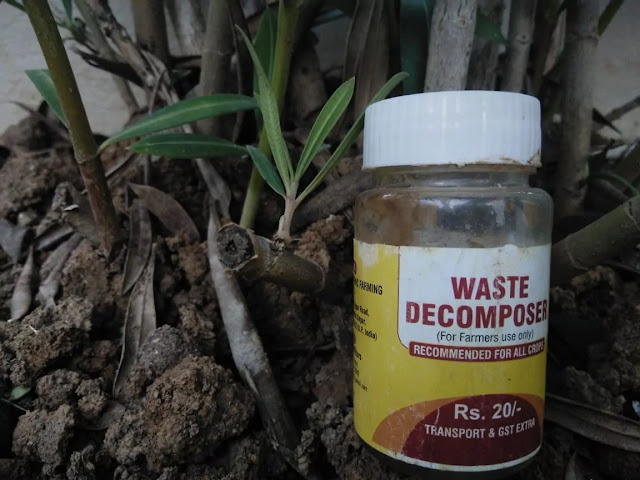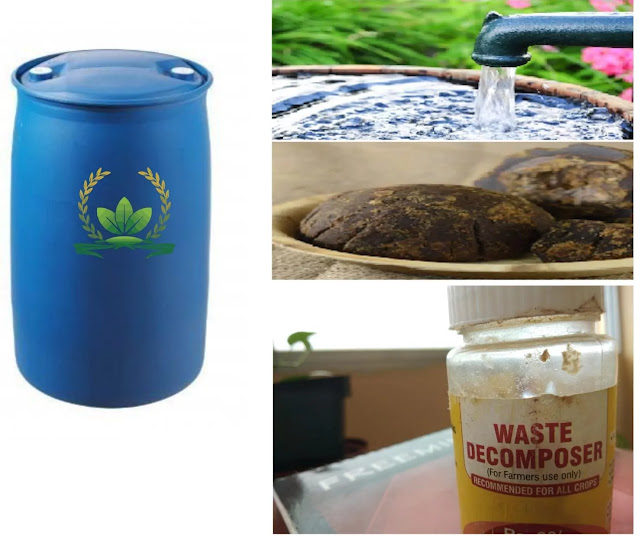Table of Contents
What is Waste Decomposer?
Waste decomposer is a bio-fertilizer, bio-pesticide, bio-control and soil health reviver developed in National Centre Of Organic Farming, Ghaziabad (India) by Dr. Krishan Chandra. It is basically a consortium of few beneficial microorganisms produced from Indian cow dung.
These microorganisms produces primary metabolites that are a precursor of anti microbial compounds. It also produces anti microbial secondary metabolites including polyketides and alkanes.
These antibacterial microbes in the farm soil and plants controls and prevents diseases. They also produces glucanase and β-1, 3 glucanase enzymes that helps to improve defence mechanisms of the plants.
Waste decomposer acts as quick decomposer of waste compounds in the soil and has been prepared from cow dung by Dr. Krishan Chandra.
This amazing multipurpose bio-fertilizer can be used in large scale agricultural farms as well as in home garden. The process to prepare this manure is very easy, cost effective and take only 5 days to be prepared.
It costs only 20 Rupees to buy a bottle of waste decomposer. The shelf life of this manure is three years. Once you have prepared the solution of microbes in your farm or home garden then you can use the same solution to make more manure again and again.
Farmers or garden enthusiast doesn’t need to depend on costly fertilizers or pesticides after using this manure. It does all work for your plants. I will suggest all my readers to use this once and observe its benefits.
READ MORE: JEEVAMRUT COMPLETE GUIDE
How to prepare solution of waste decomposer?
Waste decomposer is the basic material required for preparing a mass multiplication solution of useful microbes. In this article I will discuss both techniques of preparation for large scale farm lands as well as for urban gardens in cities.
In large scale farms you can prepare mass multiplication solution in a 200 litres plastic drum. Only use plastic drum for this purpose. Avoid using any metallic material in the whole process.
You can buy waste decomposer pack from here: Purchase Waste Decomposer
Materials required are:
- Plastic Drum (200 litres capacity)
- Jaggery (2 Kg)
- Waste Decomposer (one bottle)
- Water
Process
- Fill the plastic drum with 200 litres of water and mix 2 Kg Jaggery in water with the help of a wooden stick.
- Empty a bottle of waste decomposer in the water drum and stir the mixture very well with the help of a wooden stick.
- Cover the drum properly with plastic or wooden material. For 5 days you have to open the covering only when you will stir the culture.
- Stir the culture twice in a day for 5 minutes with the help of a wooden stick.
- After 5 days the solution will turn creamy. After 7 days you can use this solution mixed with water in 1:3 to spray in your farm.
Once you have formed this solution you can use it again and again to make more solutions. To make more solution save 20 litres of prepared solution and mix it with 2 Kg jaggery in 200 litres water in the same plastic drum.
After 7 days this solution will become ready to be used. You can repeat this process to make more and more solutions to use in your farm and save lots of money that you are spending on fertilizers and pesticides.
READ MORE: HOW TO CONTROL MEALYBUGS
How to make waste decomposer at home?
If you do not have farm land but you have your own terrace or balcony garden then also you can prepare and use this solution in your plants to get good results.
For home gardening purpose you can prepare this solution in a smaller amount. If you have large space then you can try the process mentioned above.
But to prepare this solution for home garden for very small scale purpose you will need,
- 25 Litres capacity plastic bucket,
- Jaggery (200 grams)
- Waste decomposer (3 grams)
- Water ( 20 litres)
Process
- Fill the plastic bucket with 20 litres of water, add 200 grams jaggery in the bucket and 3 grams of waste decomposer.
- Stir the solution with the help of a wooden stick and cover the drum properly with plastic and wooden cover.
- Stir the solution twice in a day for 5 minutes daily. After 6 days this solution will become ready to be used.
- Mix 3 parts of this solution in 10 parts of water i.e. 30% solution. You can spray this solution in the form of a spray once after every 7 days on your plants.
Once you have prepared this solution you can use it again and again to prepare more solution. To prepare more solution take 2 litres of the prepared solution and mix it in 20 litres of water with 200 grams of jaggery and 3 grams of waste decomposer.
Stir the solution daily and after 7 days you can use this solution again.
Waste decomposer uses
- Waste decomposer can be used in the form of bio-pesticides. Dilute the prepared solution with water in 1:3 and apply as a foliar spray to control pest and diseases.
- It increases soil health and improves fertility of the soil. This prepared solution can be used for seed treatments before sowing.
- Regular use of the solution improves crop yield and quality.
- Crop sprayed by this solution are not eaten by Blue bulls.
- This solution can be used for all crops and is cost effective, time saving and easy to use. In comparison to other manures that takes months to be prepared, you can prepare this solution within a week.
- Dependency of various types of manures, fertilizers, pesticides, insecticides and fungicides is reduced to zero after using waste decomposer.
- One small bottle of the starter culture can help to produce one lakh metric tonne organic manure in a year.
- It is simple and reliable to use.
FAQ On Waste Decomposer
Name any two biofertilizers in hindi?
Rhizobium and Azospirillium are common biofertilizers that are used in many parts of the world.








how to use this in composting kitchen waste?
Spread the mass multiplication solution of waste decomposer over kitchen waste in decomposition chamber or container. In a small container i.e. used in home, one to two litres of the solution is enough. Ideally one tonnes of decomposition material requires 20 litres of waste decomposer solution. Keep turning the organic matter in the chamber in the interval of 7 days, it will increase microbial activities in the chamber. I hope this information will help you. Thanks for connecting.
How to use decomposer in arecanut plants?
You can use waste decomposer by spraying on plant leaves once after every 10 to 15 days or you can also mix it with organic fertilizers before applying them in the fields. I hope this will help!
can we spray without dilution on Neemu Plants and Curry Leaves Plant for better results?
Hi,
Dilution with water is necessary for using waste decomposer.
Can you deliver it to Nepal ??
Hi,
At present we are not selling this product. However you can get waste decomposer from online stores like Amazon.
I hope this will help!
Instead of spraying can we give 1:3 waste decomposer solution directly to soil ?
Yes you can either spray on plants or apply 1:9 solution directly to the soil.
How much times this decomposer used in sugarcane plant?
Hi,
You can use waste decomposer at an interval of about 10 to 15 days.
I can see small Wrigley white coloured insects in my WDC WDC solution… please can you guide me how to control it and the reason why it is formed
Hi,
It is quite normal to observe growth of white crawling insects in waste decomposer solution if it is kept stable for some days. To avoid this strain out insects from the solution, stir the solution daily, and cover it properly.
I hope this will help!
Without jaggery wdc jel can use?
Jaggery is necessary for multiplication of microbes, hence it is necessary to add jaggery in waste decomposer solution.
I hope this will help!
Any adverse effects if more proportion of WDC culture is used in preparation? Very difficult to measure 3gms
Yes you can add a little more amount, but use at least 20 litres of water.
I hope this will help!
Fifteen year old Mango tree in my backyard is about to bloom now in November.
How can I use the waste decomposer solution for this Mango tree as a fertilizer and pesticide ? How frequently should I use ? Thank you.
Hi,
You can use 20 litres of waste decomposer solution for one mango tree. In an acre spray 200 litres of waste decomposer and water solution in 1:3. Spray once in every month to support plant growth and health.
I hope this will help!
Hi sir ..im wali i stay in ethiopia to get waste decomposer frm india to ethiopia is to much cost bcz courier is to costly ..can i make waste decomposer at home ? If any remedy is there plz sujest
Hi,
Instead of waste decomposer, you can prepare jeevamrut at home. Visit the guide on making jeevamrut from here – “Preparation Of Jeevamrut.”
This bio fertilizer is similar to waste decomposer and can be prepared at home.
I hope this will help!
Can we use waste decomposer solution for preparing bio enzymes?
According to Dr. Chandra we should not add any bio-enzyme in Waste decomposer but you can definitely use them to prepare bio-enzyme by using seeds.
Hii sir can I use this before 1 week to directly soil ,before preparation of any vegetable crops
Yes you can apply waste decomposer solution before plantation, but dilute it with water before applying.
Hello I am Rajni this side
What is the ratio for soil drenching in potted plants(mostly desi gulab)
Use 1:3 ratio for using waste decomposer.
Hello sir,
I am a farmer from karnataka growing sugarcane in my farm can I mix liquid consortia (mixture of It is a consortium of Rhizobium, Azotobector, Azospirillum, Phosphobacteria, and Potash Solubilizing biofertilizers) with bio waste decomposer solution that has been prepared in 200 liters of drum
Hi,
According to Dr. Chandra’s video, Rhizobium is already present in Waste decomposer solution so there is no need of adding them.
I hope this will help!
Hi Aditya,
Can I use this waste decomposer solution to my mulberry farm. When can I stop using this before feeding it to silkworms.
Refering to sericulture.
dear Aditya.
good evening..
can I use Waste Decomposer solution in the soil to increase the fertility…
can I spray on flowery plant and vegetable plant for more produce…
can I consume the vegetables if it has been sprayed with waste decomposer solution…
thanks
Hi,
Yes, spraying waste decomposer timely increases soil fertility, and productivity. It is organic and completely safe, but wash fruits and vegetables with water before consuming.
I hope this will help!
There are some white worms in my waste decomposer solution. Are they harmful or useful. If harmful then how to control it.
Hi,
I have already answered similar question in the comments. You can check to for reference.
I hope this will help!
Can cow urine and butter milk and cowdung be added to wdc preparation?? If yes how much quantity
There is no need to add anything extra, only add jaggery in required amount to start the process.
I am using wdc but land beside me farmer using chemical fertilizers, will that effect my land.
Yes, it is going to affect your land if the distance between two farms, one being organic and the other inorganic is less than 50 feet.
I stir the wdc solution twice a day as instructed and is properly covered too but then too there are white worms in the solution.
Strain the solution and reuse it, generally due to the rainy season, the worm population increase exponentially.
dear Sir
can you please mention what are the bacteria types including in this ” waste decomposer”
this is for my knowledge. Because i am confused with “BOKASHI” solution which is also use
decompose kitchen waste.
please clear me…
Hi,
It contains Bacillus sp., Corynebacterium sp., Lactobacillus sp., few fungal sp., (Aspergillus and Trichoderma).
dear sir
thank you for the reply and can you tell me what difference with
“Bokashi preparation” with WDC.?
Because i applied “bokashi preparation” on to pre composting process before introduced to
worm’s bed. After 3 weeks later i put half composted materials to my worm’s bed. Finally, i noticed worms’ population reduced. But when i used WDC for pre-composting process and applied to wormy bed after 3 weeks worm population increased gradually without any hassle. can you explain it to me sir what is the possibility to happen like this since Lactobacillus is available in both solutions.
.